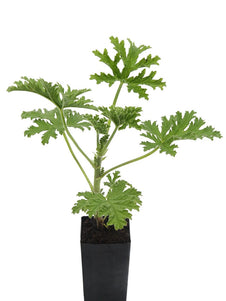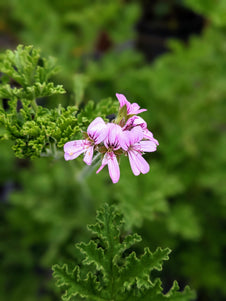



Scented Geranium Rose
Scented Geranium Rose

- In stock, ready to ship
- Inventory on the way

Usually available: April to November
Life cycle: Perennial
Height: 1.3m
Position: Sun / part shade
Soil preference: Well drained
This is how we pack and send your Herb Plants to all states except TAS & WA
You will receive
- 1 Scented Geranium Rose Herb Plant in a 50 X 75mm tube - General growing instructions
All of our Herb Plants are grown organically with certified organic potting mixes and fertilizers
Botanical Name: Pelargonium graveolens
The Rose Scented Geranium is an erect, multi-branching evergreen shrub growing to 1.3 M high by 1 meter wide. It is herbaceous when young, but as the branches age they become woody. The stems are hairy and the leaves have a covering of many glandular hairs, which create a soft velvety texture. The leaves have a strong rose scented aroma. The leaves are mid green, palmately lobed and heart shaped at the base. The flowers have 5 light pink petals and are held in pseudo-umbels, or loose clusters. Each petal has a distinctive set of crimson coloured stripes extending out from the centre. The flowering period is from late winter to summer, with a peak in spring.
The Rose Scented Geranium has the genus name ‘pelargonium’ which comes from the Greek word ‘pelargos’, meaning stork. This is a reference to the shape of the fruit which looks like a stork’s beak. Pelargoniums are called ‘storkbills’ in some areas of the United States. The species name ‘graveolens’ means ‘strong smelling’ in Latin and refers to the strong fragrance in the leaves. This species has many hybrids and cultivars that have been developed to take advantage of the strong fragrance. Common names may include Rose Geranium and Old Fashioned Rose Geranium.
The original wild variety of Pelargonium graveolens is quite uncommon and is confined to only two limited regions in South Africa. Each has hot summers and mild winters, with varying rainfall. The plants grow in hilly or mountainous areas, usually in sheltered and moist positions. The cultivated variety of P. graveolens is said to be a hybrid of the original wild type. Many additional hybrids and cultivars have since been developed and are highly valued as ornamental plants by gardeners.
Pelargonium General Notes
Pelargoniums are evergreen perennials, sharing many common characteristics with the Geranium species. They range in height from 30- 100cm and may be categorized based on varying leaf shapes, such as crinkled, oak or fern leaf shapes. The leaf colour may vary from deep to light green, with flowers generally held in loose clusters. Most prefer to grow in full sun and they are also drought and heat tolerant. However, some varieties do require some shade and moist conditions where possible. Many grow near streams in their native habitats, but generally ‘less is more’ is a good guideline for watering these plants. They do not like to be damp at all.
This group of plants were initially catalogued by Linnaeus into the same Genus as Geraniums, but were separated into separate genera in 1789. Pelargoniums were taken to England in 1631, but it is likely they were transported to Holland in the earlier 1600’s. Since early times various varieties have been developed and many are now cultivated commercially for the essential oils used in perfumery and aromatherapy.
The Pelargonium genus is one of five in the family Geraniaceae, which has over 800 species. This includes the separate Geranium genus, which often causes confusion since ‘geranium’ is also used as a common name for the many Pelargonium species and cultivars. There is thought to be 270 species of Pelargonium, with 219 being native to South Africa. Among these, there is a number of genera or subtypes of pelargonium based on features such as leaf type. Of this selection about 80% are native only to select areas in the southern regions of South Africa. The remaining 20% are found in Australia, New Zealand and a few select areas such as Madagascar and Eastern Africa. There are now cultivated varieties all over the world, most with origins in South Africa. The true Geranium species is a hardy group of plants native to North America and Europe.
The Geranium plant family is an important food source for certain Lepidoptera species in their native regions. For more information on our other Scented Geranium varieties.
Growing Conditions
Most pelargoniums enjoy full sun, but Rose Scented Geranium is one variety that requires more shelter. Pelargonium graveolens grows very well in semi-shaded positions and is good as a filler plant in larger gardens. It requires a moist, but not damp environment, with well- drained soil.
This plant also grows well in containers and hanging baskets. In cold regions it may even be taken indoors, but may be better treated as an annual if this is not possible. Although, not very tolerant of frost some plants may die down and return when the weather warms in spring. It may be propagated by tip or stem cuttings taken in autumn or spring.
Culinary Uses
Pelargoniums are usually suitable for culinary use, particularly the leaves and flowers. They may be used for herbal teas and to sweeten and scent desserts such as cakes and jelly. The most commonly used are those with rose, lemon and peppermint scents. Leaves may be cut and placed in ice cube trays for later use in iced tea or other suitable cold drinks.
A tea infusion may be made using 3 teaspoons of freshly chopped leaves, or 1 teaspoon of dried leaves, and 1 cup (250mls) of boiling water. Let the leaves steep, strain and then drink as needed. There are several varieties suitable for a tea infusion, but it may be a matter of taste.
Medicinal Uses
Many South African varieties of Pelargonium have a history of traditional medicine use by local tribes. General traditional use has included treatment for digestive and respiratory ailments, wounds, burns, ulcers and abscesses, cold sores and sore throats. The active chemicals are slightly astringent so they are good for skin care, oily skin and cleansing the pores. Overall the pelargonium species are seen as having value for creating a relaxing and uplifting feeling, while calming nerves, anxiety and aiding depression. There is also value for use in premenstrual tension and for those seeking an essential oil for creating a soothing and balancing effect on the body. Different varieties may have different effects.
The strongly scented Rose Scented Geranium, Pelargonium graveolens, is one of the best plants in this genus for traditional medicine use. Several active chemicals, in this species, have been determined to be beneficial for having antibiotic effects and nerve pain relief. Research has indicated it is helpful for nerve pain associated with shingles. It is thought to also have a soothing effect on the skin when used to bath rashes, skin irritations or simply used in bath water.
Other Uses
Many of the scented pelargonium species and varieties are cultivated especially for their use in perfumery, aromatherapy and massage therapy. Rose Scented Geranium is often used as a substitute for Rose of Attar. The oil is extracted from the leaf and stems of the plant.
All information provided on this website is for informational purposes only. Please seek professional advice before commencing any treatment.





